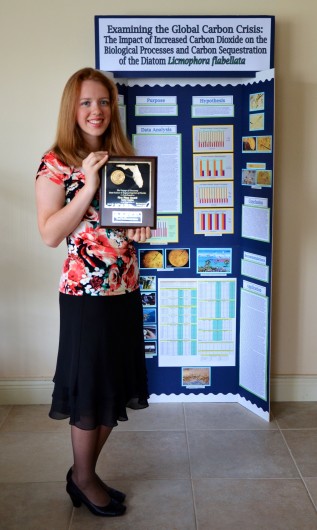NSU Newsroom
SharkBytes
Horizons
This version of NSU News has been archived as of February 28, 2019. To search through archived articles, visit nova.edu/search. To access the new version of NSU News, visit news.nova.edu.
This version of SharkBytes has been archived as of February 28, 2019. To search through archived articles, visit nova.edu/search. To access the new version of SharkBytes, visit sharkbytes.nova.edu.
University School Sophomore Wins State and Advances to International Science Competition
Recognized for her examination of the global carbon crisis, University School sophomore Rachel Sereix, followed a first place win at the Broward County Science Fair with a first place win at the Florida State Science and Engineering Fair and an invitation to the Intel International Science and Engineering Fair. As she prepares for the world’s largest pre-college science competition, she reflects on her research and offers advice to budding scientists.
“What I am most excited about is that I get to present my experiment to scientists from Stanford, National Geographic and other prestigious colleges and organizations,” Sereix said. “Not only will I develop connections and further understanding of my subject matter, but I also have the opportunity to present my research to people who may not be involved with the world of diatoms.”
Sereix’s project demonstrated that the smallest form of aquaculture, diatoms, can serve as indicators of environmental mitigation. This means that scientists on either side of the global warming issue can examine the thin, pasty film seen floating near coral reefs to gauge the depletion of macro nutrients, disruption of the food chain, inhibition of aqua photosynthesis, and reduction in aquatic resilience to thermal stress. In simple terms, diatoms turn bad, gaseous carbon into good, solid carbon that drops to the ocean floor and produces the calcium carbonate that makes up the coral reefs. As diatoms diminish, coral reef resilience diminishes signaling unfavorable humanistic and aquatic implications associated with global warming.
After spending the summer reading scientific literature to advance her knowledge of ocean chemistry and diatom features and processes, Sereix conducted her four-month experiment at Florida Atlantic University’s Gumbo Limbo Marine Science Center. During the experiment period, she had the opportunity to measure quantum yield (the activity of electrons within each photosystem) using the state-of-the-art Pulse Amplitude Modulation Fluorometry technique.
Next month Rachel will be among the 1,500 high school students from over 70 countries, regions, and territories who will showcase their independent research and compete for more than $3 million in awards at the Intel International Science and Engineering Fair. Entry into these prestigious science competitions is facilitated by USchool’s Science Research Coordinator, Arnold I. Miller.
